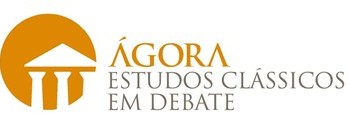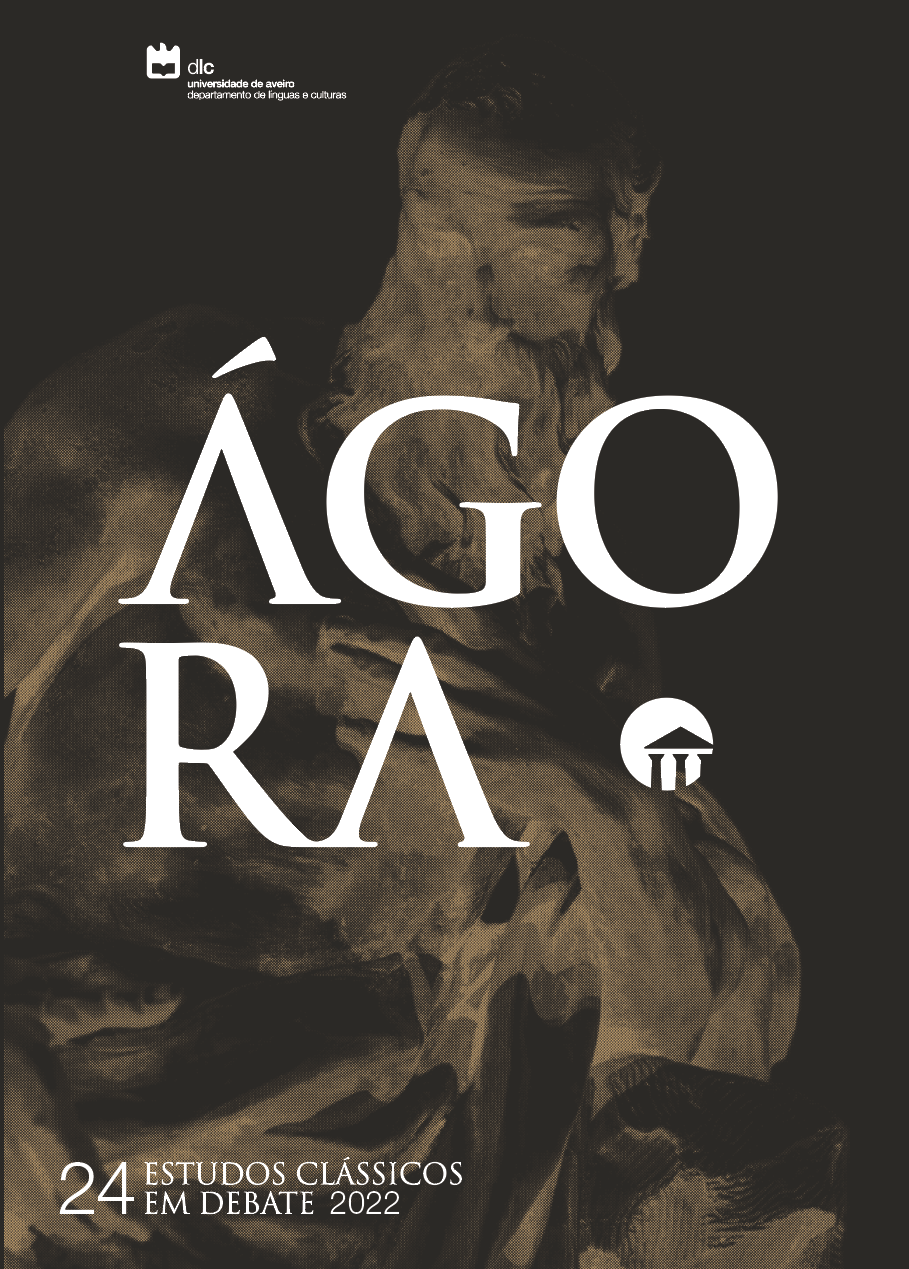Using the Aeneid to Negotiate Difference: Identity, Difference and Narratives of Belonging
Palavras-chave:
Eneida;, identidade;, narrativa;, diferença;, nacional;, pós-nacional.;
Resumo
O objetivo deste texto é assinalar a importância da Eneida de Vergílio para compreender a concetualização e o aparecimento da identidade tanto nacional como pós-nacional A tentativa de Vergílio de criar uma narrativa coerente que represente o fundamento da identidade nacional romana será comparada com a tentativa da Comissão Europeia de criar uma narrativa coerente que represente a base da identidade pan-europeia. Infelizmente, quer a Eneida quer a ideia de uma narrativa da fundação europeia foram mal interpretadas por grupos de extrema direita e anti-imigrantes.
Downloads
Dados de Download não estão ainda disponíveis.
Referências
ANDERSON, B. (1983), Imagined Communities: Reflections on the origin and spread of nationalism. London, New York, Verso.
APPLEBAUM, A. (2017), “A new European narrative?”: The New York Review of Books, October 12. https://www.nybooks.com/articles/2017/10/12/new-european-narrative/.
BARROSO, J. M. (2012) “State of the union address”: European Commission. https://ec.europa.eu/soteu2012/index_en.htm.
BARROSO, J. M. (2014). ”Moving towards a conscience of Europe.” European Commission Press Release Database, May 9. http://europa.eu/rapid/press-release_SPEECH-14-368_en.htm.
BEE, C. (2008), “The ’institutionally constructed’ European identity: Citizenship and public sphere narrated by the Commission”: Perspectives on European Politics and Society 9 (2008) 431-450.
BOWRA, C.M. (1993), “Aeneas and the stoic ideal”: Greece & Rome 3 (1993) 8 21.
BUDIMIR, M.; FLASAR, M. (1991), The history of Roman literature. Beograd, Naucna knjiga.
GALE, M. R. (2006), “National identity in the Aeneid”: Classical Review 56 (2006) 106-108.
ELIOT, T. S. (1957), On poetry and poets. London, Faber and Faber.
EUROPA NOSTRA (2014), “New narrative for Europe.” Presented in Berlin with President Barroso and Chancellor Merkel. March 3. https://www.europanostra.org/new-narrative-europe-presented-berlin-president-barroso-chancellor-merkel/
EUROPEAN UNION (2007), Consolidated version of the Treaty on European Union, December 13. https://www.refworld.org/docid/4b179f222.html.
EUROPEAN YOUTH PORTAL (2016), “New narrative For Europe”. European Union. https://europa.eu/youth/eu/article/50/36003_en accessed.
HABERMAS, J. (1992), “Citizenship and national identity: Some reflections on the future of Europe”: Praxis International 12 (1992) 1-19.
IVIC, S.; LAKICEVIC, D. (2011), “European identity: Between modernity and postmodernity”: Innovation: The European Journal of Social Science Research 24 (2011) 395-407
IVIC, S. (2019), “The concept of European values”: Cultura. International Journal of Philosophy of Culture and Axiology 16 (2019) 103-117.
IVIC, S. (2016), European identity and citizenship: Between modernity and post-modernity. London, Palgrave Macmillan.
JACOBS, D.; MAIER, R. (1998), “European identity: construct, fact and fiction”: M. GASTELAARS; A. RUIJTER (eds.) (1998), A united Europe: The quest for a multifaced identity, Maastricht: Shaker, 13-34.
KAISER, W. (2015), “Clash of cultures: Two milieus in the European Union’s ‘A new narrative for Europe’ project”: Journal of Contemporary European Studies 23 (2015) 1-14.
KORFMACHER, W. C. (1956), “Vergil, spokesman for the Augustan reforms”: The Classical Journal 51 (1956) 329-334.
MACKIE, C. (2017), “Guide to the Classics: Virgil's Aeneid.” The Conversation, October 23. https://theconversation.com/guide-to-the-classics-virgils-aeneid-85459
MARCELO, G. (2017), “Narrative and recognition in the flesh: An interview with Richard Kearney”: Philosophy and Social Ciriticism 43 (2017) 777-792.
MEYER, T. (2004), Die identität Europas: Der EU eine seele? Frankfurt am Main, Suhrkamp Verlag.
RADENOVIC, S. (2006), “National identity, ethnicity and cultural memory”: Filozofija i društvo 3 (2006) 221-237.
REDING, V. (2012), “Why we need a United States of Europe now.” European Commission, Press Release Database, November 8. http://europa.eu/rapid/ press-release_SPEECH-12-796_en.htm
REED, J. D. (2007), Virgil’s gaze: Nation and poetry in the Aeneid. Princeton, Princeton University Press.
RICOEUR, P. (1992), Oneself as another, trans. Kathleen BLAMEY. Chicago, University of Chicago Press.
RISSE, T.; GRABOWSKY, J. K. (2008), “Foreign Identity formation in the public sphere and in foreign policy.” RECON Online Working Paper. http://www.reconproject.eu/main.php/RECON_wp_0804.pdf?fileitem=50511948
SANGCO-JACKSON, G. A. (2006), “Imaginary identity: Aeneas’ search for a home in Aeneid 3.” [Master's thesis] Gainesville, University of Florida.
SHORE, C. (1993), “Inventing the ‘people's Europe’: Critical approaches to European community 'cultural policy’”: Man, New Series 28 (1993) 779 800.
SOMERS, M. (1994), “The narrative constitution of identity: A relational and network approach”: Theory and Society 23 (1994) 605-649.
STRATH, B. (2002), “A European identity: To the historical limits of the concept”: European Journal of Social Theory 5 (2002) 387-401.
SYED, Y. (2005), Vergil’s Aeneid and the Roman self: Subject and nation in the literary discourse. Michigan, University of Michigan Press.
THE AENEID (2020), Important Questions Explained. https://www.sparknotes.com/lit/aeneid/quotes/page/3/.
TEKIN, B. (2014), “Rethinking the post-national EU in times of austerity and crisis”: Mediterranean Politics 19 (2014) 21-23.
TOLL, K. (1997), “Making Roman-Ness and the ‘Aeneid'“: Classical Antiquity 16 (1997) 34-56.
UKESSAYS (2018), How Virgil integrates myth and history in the Aeneid. https://www.ukessays.com/essays/classics/how-virgil-integrates-myth-and-history.php?vref=1
VERGIL (1909), Virgil's Aeneid, trans. John DRYDEn with Introduction and Notes. New York, P.F. Collier and Son.
VERGIL (2006), The Aeneid, translated by Robert FAGLES. Harmondsworth, Viking Penguin.
VERGILIAN SOCIETY (2020), “Call for papers: 'Identity in Vergil.” Symposium Cumanum 2021. https://www.vergiliansociety.org/call-for-papers-identity-in-vergil-symposium-cumanum-2021/.
VESTER, C. (2005), “Destiny, desire, and the hero in Virgil's Aeneid. Part one: Drawing upon love.” Labyrinth 87, https://uwlabyrinth.uwaterloo.ca/labyrinth_archives/destiny_desire_and_the_hero_in_virgils_aeneid.pdf.
VRATOVIC, V. (2008), Roman literature. Zagreb, Biakova.
WILLIAMSON, M. (2019), “Vergil’s Aeneid: The cornerstone of Roman identity”: Tenor of Our Times 8 (2019) 159-171.
WIMPERIS, T. A. (2017), “Cultural memory and constructed ethnicity in Vergil's Aeneid.” [PhD thesis] Chapel Hill, University of North Carolina.
WODAK, R.; DE CILLIA, R.; REISIGL, M.; Liebhart, K. 2009. The Discursive Construction of National Identity, Second Edition. Edinburgh: Edinburgh University Press.
APPLEBAUM, A. (2017), “A new European narrative?”: The New York Review of Books, October 12. https://www.nybooks.com/articles/2017/10/12/new-european-narrative/.
BARROSO, J. M. (2012) “State of the union address”: European Commission. https://ec.europa.eu/soteu2012/index_en.htm.
BARROSO, J. M. (2014). ”Moving towards a conscience of Europe.” European Commission Press Release Database, May 9. http://europa.eu/rapid/press-release_SPEECH-14-368_en.htm.
BEE, C. (2008), “The ’institutionally constructed’ European identity: Citizenship and public sphere narrated by the Commission”: Perspectives on European Politics and Society 9 (2008) 431-450.
BOWRA, C.M. (1993), “Aeneas and the stoic ideal”: Greece & Rome 3 (1993) 8 21.
BUDIMIR, M.; FLASAR, M. (1991), The history of Roman literature. Beograd, Naucna knjiga.
GALE, M. R. (2006), “National identity in the Aeneid”: Classical Review 56 (2006) 106-108.
ELIOT, T. S. (1957), On poetry and poets. London, Faber and Faber.
EUROPA NOSTRA (2014), “New narrative for Europe.” Presented in Berlin with President Barroso and Chancellor Merkel. March 3. https://www.europanostra.org/new-narrative-europe-presented-berlin-president-barroso-chancellor-merkel/
EUROPEAN UNION (2007), Consolidated version of the Treaty on European Union, December 13. https://www.refworld.org/docid/4b179f222.html.
EUROPEAN YOUTH PORTAL (2016), “New narrative For Europe”. European Union. https://europa.eu/youth/eu/article/50/36003_en accessed.
HABERMAS, J. (1992), “Citizenship and national identity: Some reflections on the future of Europe”: Praxis International 12 (1992) 1-19.
IVIC, S.; LAKICEVIC, D. (2011), “European identity: Between modernity and postmodernity”: Innovation: The European Journal of Social Science Research 24 (2011) 395-407
IVIC, S. (2019), “The concept of European values”: Cultura. International Journal of Philosophy of Culture and Axiology 16 (2019) 103-117.
IVIC, S. (2016), European identity and citizenship: Between modernity and post-modernity. London, Palgrave Macmillan.
JACOBS, D.; MAIER, R. (1998), “European identity: construct, fact and fiction”: M. GASTELAARS; A. RUIJTER (eds.) (1998), A united Europe: The quest for a multifaced identity, Maastricht: Shaker, 13-34.
KAISER, W. (2015), “Clash of cultures: Two milieus in the European Union’s ‘A new narrative for Europe’ project”: Journal of Contemporary European Studies 23 (2015) 1-14.
KORFMACHER, W. C. (1956), “Vergil, spokesman for the Augustan reforms”: The Classical Journal 51 (1956) 329-334.
MACKIE, C. (2017), “Guide to the Classics: Virgil's Aeneid.” The Conversation, October 23. https://theconversation.com/guide-to-the-classics-virgils-aeneid-85459
MARCELO, G. (2017), “Narrative and recognition in the flesh: An interview with Richard Kearney”: Philosophy and Social Ciriticism 43 (2017) 777-792.
MEYER, T. (2004), Die identität Europas: Der EU eine seele? Frankfurt am Main, Suhrkamp Verlag.
RADENOVIC, S. (2006), “National identity, ethnicity and cultural memory”: Filozofija i društvo 3 (2006) 221-237.
REDING, V. (2012), “Why we need a United States of Europe now.” European Commission, Press Release Database, November 8. http://europa.eu/rapid/ press-release_SPEECH-12-796_en.htm
REED, J. D. (2007), Virgil’s gaze: Nation and poetry in the Aeneid. Princeton, Princeton University Press.
RICOEUR, P. (1992), Oneself as another, trans. Kathleen BLAMEY. Chicago, University of Chicago Press.
RISSE, T.; GRABOWSKY, J. K. (2008), “Foreign Identity formation in the public sphere and in foreign policy.” RECON Online Working Paper. http://www.reconproject.eu/main.php/RECON_wp_0804.pdf?fileitem=50511948
SANGCO-JACKSON, G. A. (2006), “Imaginary identity: Aeneas’ search for a home in Aeneid 3.” [Master's thesis] Gainesville, University of Florida.
SHORE, C. (1993), “Inventing the ‘people's Europe’: Critical approaches to European community 'cultural policy’”: Man, New Series 28 (1993) 779 800.
SOMERS, M. (1994), “The narrative constitution of identity: A relational and network approach”: Theory and Society 23 (1994) 605-649.
STRATH, B. (2002), “A European identity: To the historical limits of the concept”: European Journal of Social Theory 5 (2002) 387-401.
SYED, Y. (2005), Vergil’s Aeneid and the Roman self: Subject and nation in the literary discourse. Michigan, University of Michigan Press.
THE AENEID (2020), Important Questions Explained. https://www.sparknotes.com/lit/aeneid/quotes/page/3/.
TEKIN, B. (2014), “Rethinking the post-national EU in times of austerity and crisis”: Mediterranean Politics 19 (2014) 21-23.
TOLL, K. (1997), “Making Roman-Ness and the ‘Aeneid'“: Classical Antiquity 16 (1997) 34-56.
UKESSAYS (2018), How Virgil integrates myth and history in the Aeneid. https://www.ukessays.com/essays/classics/how-virgil-integrates-myth-and-history.php?vref=1
VERGIL (1909), Virgil's Aeneid, trans. John DRYDEn with Introduction and Notes. New York, P.F. Collier and Son.
VERGIL (2006), The Aeneid, translated by Robert FAGLES. Harmondsworth, Viking Penguin.
VERGILIAN SOCIETY (2020), “Call for papers: 'Identity in Vergil.” Symposium Cumanum 2021. https://www.vergiliansociety.org/call-for-papers-identity-in-vergil-symposium-cumanum-2021/.
VESTER, C. (2005), “Destiny, desire, and the hero in Virgil's Aeneid. Part one: Drawing upon love.” Labyrinth 87, https://uwlabyrinth.uwaterloo.ca/labyrinth_archives/destiny_desire_and_the_hero_in_virgils_aeneid.pdf.
VRATOVIC, V. (2008), Roman literature. Zagreb, Biakova.
WILLIAMSON, M. (2019), “Vergil’s Aeneid: The cornerstone of Roman identity”: Tenor of Our Times 8 (2019) 159-171.
WIMPERIS, T. A. (2017), “Cultural memory and constructed ethnicity in Vergil's Aeneid.” [PhD thesis] Chapel Hill, University of North Carolina.
WODAK, R.; DE CILLIA, R.; REISIGL, M.; Liebhart, K. 2009. The Discursive Construction of National Identity, Second Edition. Edinburgh: Edinburgh University Press.
Publicado
2022-03-22
Secção
Artigos










